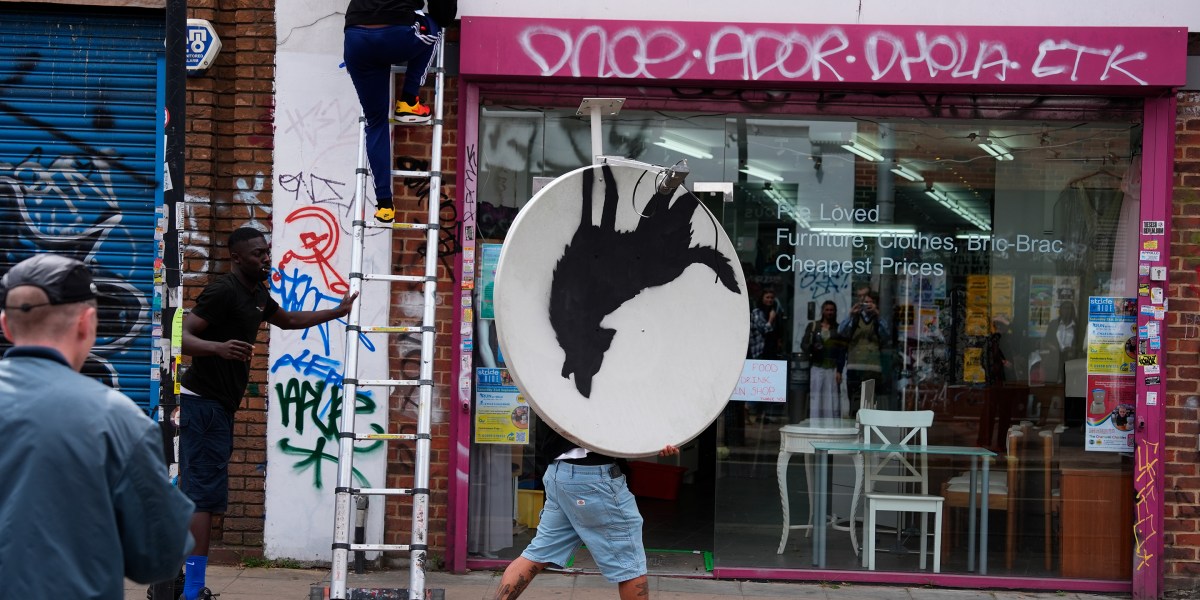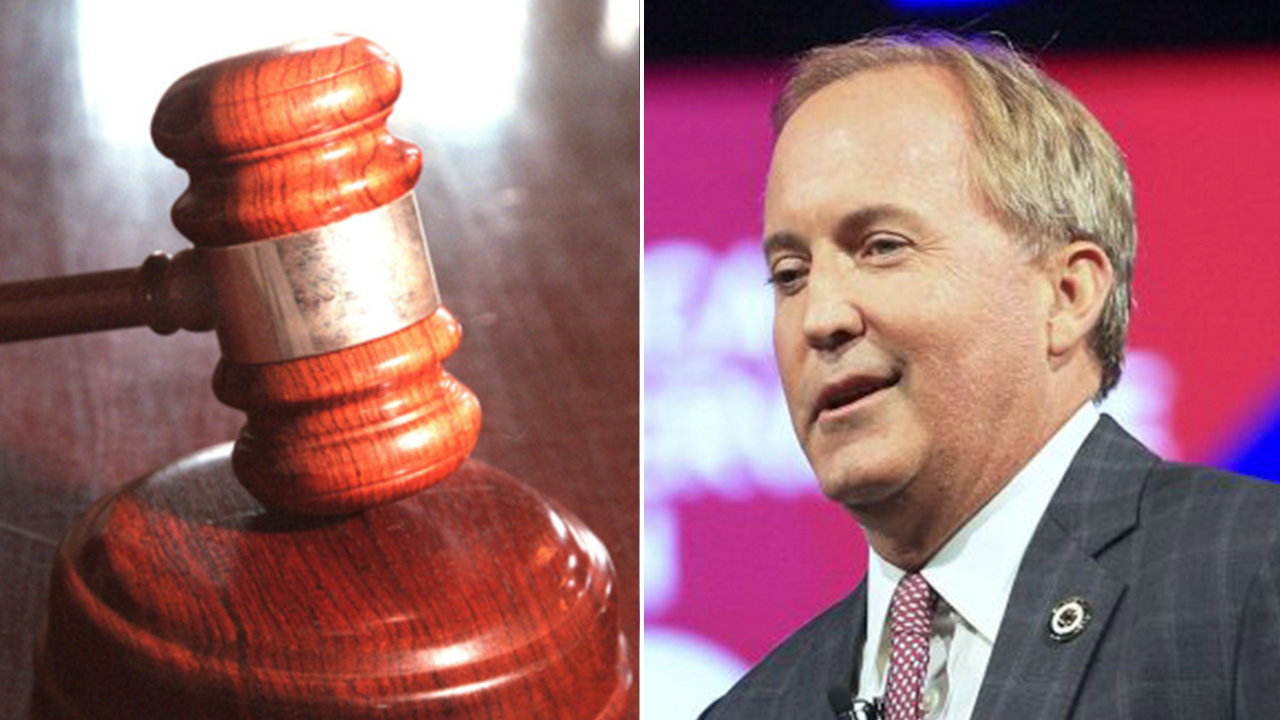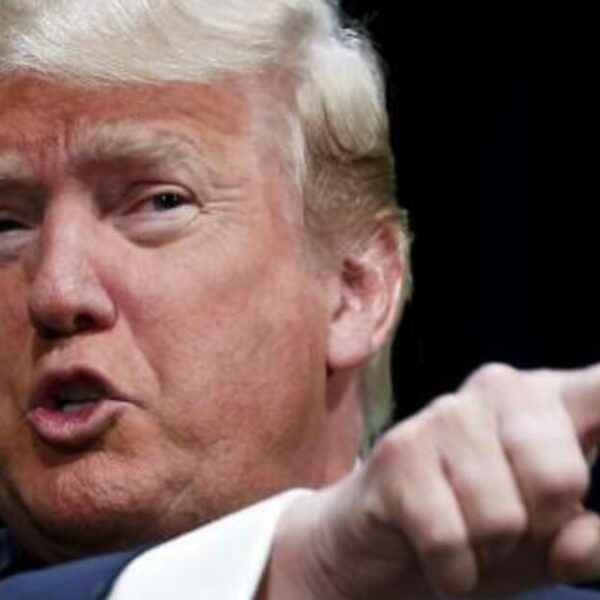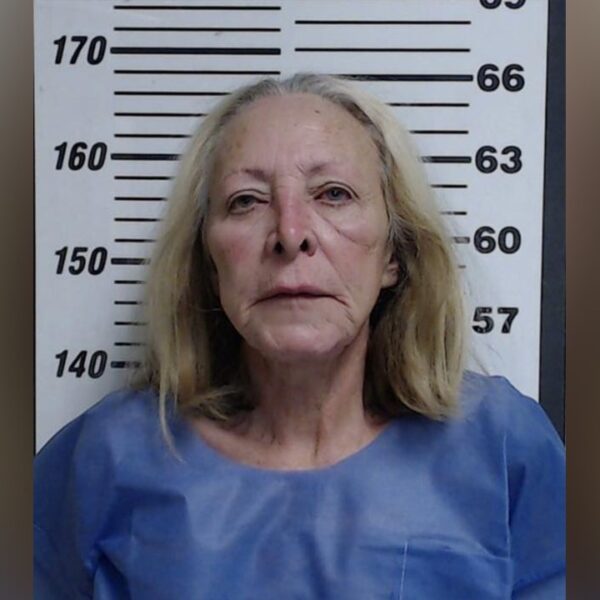As passersby in London admired the latest street art from the world-renowned anonymous artist Banksy, one man was hatching a plan.
The piece, known as the Howling Wolf, featured the animal stenciled in black paint on a white satellite dish, which served as a modern-day stand-in for a full moon. A few minutes later, the plotter and two associates used a ladder to scale the building and detach the satellite. Videos show one of the men running down the street of London’s Peckham neighborhood hauling off his prize.
It’s one that many gallerists around the world would kill for. But a stolen work of art is, first and foremost, stolen.
“As with any artwork, it is worth what someone will pay for it, but offered on the black market it holds no intrinsic value,” said Joe Syer, cofounder of art dealership MyArtBroker and an expert in Banksy’s work.
Thefts in the art world are hardly a new phenomenon. In 1990, thieves famously stole 13 works of art, including two Rembrandts and a Vermeer, from the Isabella Gardner Museum in Boston. In 1969 in Palermo, Italy, a 300-year-old Caravaggio was cut out of its frame never to be seen again (allegedly by the Sicilian Mafia). Yet the Banksy theft is unique for the brazenness of the thieves and the fact that it was immediately documented. It’s a consequence of both the smartphone age, where anyone can record a crime, and the public nature of Banksy’s street art, which means it isn’t protected by elaborate security systems as museum or gallery works are.
Given that the Howling Wolf‘s theft made global headlines, it is “certainly a hot or marked artwork now that no reputable dealer or gallerist would go near,” said Ben Cotton, director of HangUp Gallery in London, which specializes in Banksy’s work.
This presents a problem for would-be thieves: How do you sell an expensive work of art when no one will buy it?
The answer, in short, is that not all art dealers are reputable. Experts Fortune interviewed for this story, which include gallerists, lawyers with expertise in art sales, and art dealers, described plausible scenarios in which brokers with dubious morals might sell such works to interested parties. (All were clear that they had never sold or bought any stolen art.)
“I imagine that a gallery looking to sell a stolen work would want to distance themselves from having anything to do with owning it themselves,” Cotton wrote in an email. But the dealer or gallery could act as a middleman, or in this case a fence, for the stolen goods, and advertise it to prospective buyers “as a special opportunity to acquire ‘insert name of artwork’ on behalf of a private collector who is looking for a ‘discreet sale,’” Cotton said. “The gallery would likely not advertise it as widely as they would a legitimate acquisition instead concentrating their outreach to some of their more ‘open minded’ clientele.”
Sold surreptitiously, these black-market works would command far less than their price on the open market. Cotton estimates an uncertified Banksy would sell for 40% less than an authenticated work. Ray Waterhouse, an art dealer with Fine Art Brokers, believes it would be worth even less, going for “less than 50% of normal value.” Both Cotton and Waterhouse clarified they hadn’t sold stolen art themselves.


Maja Hitij
Still, it’s certain some do—and the pool of potential buyers for stolen art includes a great number of wealthy but less-than-savory characters, including drug dealers, mob bosses, and even Nazis who stole countless works of art across Europe during World War II. The Carravaggio stolen in 1969 was rumored to have hung in the home of the Mafia boss Tano Badalamenti. The stolen paintings from the Isabella Gardner Museum were linked to legendary Boston crime lord Whitey Bulger and shipped off to an IRA-affiliated gang in Ireland, according to a retired Scotland Yard detective.
“It’s always assumed there are art dealers who are less scrupulous,” said Daniel Weiner, a specialist in art law at Hughes, Hubbard, and Reed and who is also a member of the Court of Arbitration for Art, a body that resolves international disputes related to art. “We know art gets stolen and sold… when they do these drug raids of people’s houses, there’s a missing Van Gogh on the wall.”
Over the past week, Banksy, believed to be a man from Bristol, England, unveiled a series of new works across London titled “London Zoo” that depicted animals in amusing situations. There was a police booth transformed to look like a fish tank, two elephants painted on boarded up windows craning their trunks toward one another, and monkeys swinging on a subway overpass. The Howling Wolf has since become the most infamous after its near immediate theft.


SOPA Images
A representative for Banksy did not respond to a request for comment from Fortune. After the theft, Banksy’s representatives told the BBC he had “no knowledge as to the dish’s current whereabouts.”
When a work of art is stolen its owner usually files a claim with the Art Loss Registry, a private company that compiles a database of all missing artwork. The Art Loss Registry did not respond to a request for comment about whether a claim had been submitted for the Howling Wolf.
However, who exactly owns Banksy’s works of street art is a complex question. For the artist themselves, the answer is likely no one because the works belong to the public, according to Cotton. “Street art pieces on walls, doors, signs et cetera, like those seen in the recent London Zoo series, are intended to be appreciated by the public and not removed for potential commercial gain,” he said.
Much of Banksy’s appeal lies in precisely how accessible his art is, both physically and intellectually. “You do not need a degree in art history to get it,” said Cotton. “[The public] respond to the Robin Hood element of it all. He is this unidentified guy seemingly exposing so many truths in the world whilst robbing the rich and giving to the poor.”
To keep his street art public, the artist behind the Banksy moniker rarely certifies those works as officially his, making them much harder and less lucrative to sell. To get around this fact and the rampant forgeries that started popping up as his fame grew, Banksy set up his own authentication system in 2009. Cheekily named the Pest Control Office, it issues certificates of authenticity to Banksy’s work. Without a Pest Control certificate, selling even a legally obtained Banksy is difficult enough.
“You should be highly skeptical of anyone offering a Banksy for sale that cannot provide a Pest Control Certificate along with it,” Syer said.
Pest Control did not respond to multiple requests for comment.
Just because it’s uncertified doesn’t mean it’s not ‘real’
Banksy pieces that are sanctioned for sale can fetch millions. A pandemic-era work celebrating nurses and doctors sold for $23 million in March 2021. Later that year Banksy’s take on a Vincent Van Gogh still life went for $11.7 million at an auction in New York. Banksy’s most expensive painting is perhaps also his most characteristic. “Girl with Balloon” originally sold for $1.4 million in 2018 at Sotheby’s in London. As soon as the sale closed, a hidden mechanism in its picture frame triggered a paper shredder that ruined half the painting. The stunt, meant as a critique of empty consumerism, only added to the hype. In 2021, the work, since renamed “Love is in the Bin,” resold for $25 million.
The Howling Wolf’s notoriety could make it similarly appealing. “There will still be a market for it,” said Cotton. “It’s a genuine Banksy work after all that has already been seen on news channels across the world and now has a great story behind it.”
This isn’t the first time someone has tried to steal Banksy’s works of street art. Across Europe and the U.S. unlikely art thieves have tried to steal Banksy’s public works. In June a man in France received a two-year suspended prison sentence for trying to scrape Banksy graffiti off a wall. In February, police in London arrested two men for stealing a Stop sign Banksy had marked with three military drones. In San Francisco, an alleged Banksy stolen in 2013 that was drawn on the door of a metal utility box popped up in an auction in December 2021 alongside a collection of NFTs. Pest Control never confirmed the authenticity of the San Francisco work.


Aurelien Morissard/IP3
But there is a distinction between a certified work and an original. “Just because it does not have a Pest Control certification does not mean it is not real, it just means that it was not intended to be sold,” Cotton said.
Banksy previously claimed the Howling Wolf work on his Instagram, but will likely never certify it. “There is a huge difference in the true value of authenticated works of which this, once removed and on the market, would no longer be,” said Syer.
But even Banksy’s uncertified work, such as his street art, remains the work of what many in the art world consider a master. What should happen to it is its own debate. Syer says it should be maintained at all costs. “These works should stay exactly as and where they were found, allowed to be enjoyed as they were intended,” he said.
But for Cotton, the beauty of street art is precisely the fact that it is so rarely preserved. “It’s a shame when they get taken so quickly they cannot be enjoyed, but by nature street art is ephemeral and fleeting, so maybe it is all just part of the experience,” he said.















